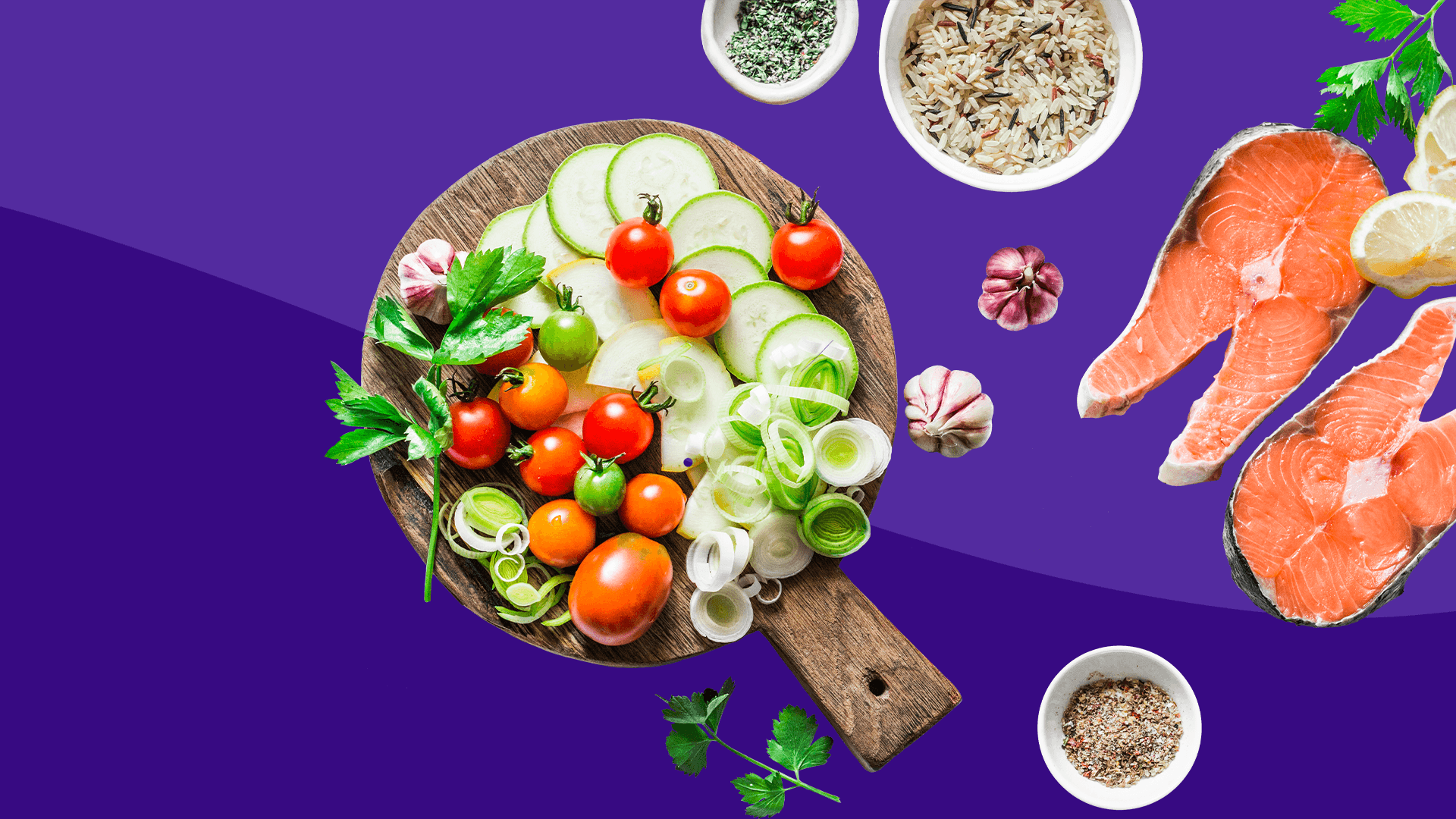Inflammation is a normal response to injury or infection. For example, if you cut your finger, roll your ankle, or come down with the flu, your immune system responds by sending white blood cells to protect the injured area or fight infection. That’s called acute inflammation, and it is protective. It helps your body begin the healing process.
Where it takes a turn for the worse is when your body continues to send inflammatory cells long after you’ve healed. This is chronic inflammation, and it’s linked to arthritis, cancer, heart disease, and diabetes, according to the American Heart Association. Your doctor or another healthcare provider can detect inflammation by measuring blood levels of C-reactive protein (CRP) and erythrocyte sedimentation rate (ESR), inflammatory markers that rise when inflammation is present.
Fortunately, there are things you can do to decrease inflammation, including following an anti-inflammatory diet. Read on to find out what the best diet for inflammation is, what foods you should include or ditch, and other ways to reduce inflammation in the body.
What is the best anti-inflammatory diet?
There are various types of diets to reduce inflammation and maintain overall health. “The goal of an anti-inflammatory diet is to try to reduce inflammation, which in turn may help with symptoms of arthritis and other inflammatory diseases,” says Robert Koval, MD, a board-certified rheumatologist at Texas Orthopedics, Sports, and Rehabilitation Associates. Although dietary changes do not offer a cure, Dr. Koval says it can help make a patient feel better while dealing with their disease. Plus, reducing inflammation can help downstream medical issues like high blood pressure, cardiovascular disease, and other conditions.
In that context, the best anti-inflammation diet will depend on a variety of factors, including the cause of your inflammation and the symptoms you’re experiencing. Acute inflammation tends to surface as swelling, heat, pain or tenderness, and flushed skin at the injury site. Some of the more common signs of chronic inflammation include:
- Fatigue
- Chest pain
- Skin rash
- Joint pain and stiffness
- Abdominal pain
- Fever
- Mouth sores
It should be noted that there is not one perfect diet for each individual. “In fact, what works for one person may not work for another, and picking the best diet often involves trial and error,” Dr. Koval says.
What’s more, an anti-inflammatory diet encompasses several eating plans. It’s not one specific diet. That said, there are a few low inflammation diets that stand out, including a Mediterranean-style diet.
Mediterranean diet
“The Mediterranean diet, specifically, is one of the best diets to combat inflammation,” says Angela L. Lago, MS, RDN, LDN, registered dietitian and clinical nutrition manager at New Hanover Regional Medical Center. It’s also an eating plan the vast majority of the population can easily follow. In addition, following a Mediterranean type plan can help safeguard against diseases that cause inflammation like Type 2 diabetes and cardiovascular disease.
The Mediterranean diet consists of whole foods that reduce inflammation like fatty fish, vegetables, fruits, and nuts. Because the diet is largely plant-based, it’s also rich in flavonoids and carotenoids. Almost all fruits and vegetables contain flavonoids—a phytonutrient with powerful anti-inflammatory, antioxidant, and immune system benefits, according to a 2016 review.
Additionally, the Arthritis Foundation cites the Mediterranean diet as a top eating plan for people with arthritis. Inflammatory diseases that may benefit from a dietary change include:
- Alzheimer’s disease
- Heart disease
- Rheumatoid arthritis (RA)
- Type 2 diabetes
- Ankylosing spondylitis (AS)
Other chronic diseases or medical conditions that may benefit from an anti-inflammatory diet include:
- Obesity
- High blood pressure
- High cholesterol
Moreover, a 2021 observational study found an association between an anti-inflammatory diet and a lower risk of developing dementia later on. Inflammation in the brain may be a contributing factor to developing dementia.
Other anti-inflammatory diets
While the Mediterranean diet reigns supreme, other anti-inflammatory diets can help prevent diseases and health conditions. The Nordic diet—which focuses on fruit, root and cruciferous vegetables, whole grains and rye products, a high intake of fish, and canola oil—is another diet that can help reduce inflammation.
If you’re dealing with high blood pressure, you may want to consider the Dietary Approaches to Stop Hypertension (DASH) diet, which is high in fruits, vegetables and whole grains, but low in inflammatory inducing foods like sweets, sugary drinks, and red meats.
Anyone considering a low-inflammation eating plan should consult a doctor or registered dietician about the best anti-inflammatory eating plan to fit their needs.
7 anti-inflammatory foods to eat
The good news? The list of foods that fight inflammation is actually quite extensive and delicious. Plus, the health benefits of the foods on this list go beyond reducing inflammation.
You’ll be increasing your intake of anti-inflammatory foods like fruits, vegetables, whole grains, fish, nuts, and healthy oils and fats. By packing your day with these nutrient-rich foods, you’ll boost your intake of vitamins, minerals, fiber, phytonutrients, and essential fatty acids, too.
1. Fatty fish
Fatty fish like mackerel, salmon, and sardines contain omega-3 fatty acids, which help reduce inflammation throughout your body. The Academy of Nutrition and Dietetics recommends eating three to four ounces of fish at least twice a week. Including fish in your diet is an excellent way to increase your intake of healthy fats.
2. Fresh fruits
Colorful berries like blueberries, strawberries, raspberries, and blackberries are loaded with vitamins, minerals, and fiber. But the biggest benefit comes from anthocyanin, an antioxidant that has anti-inflammatory properties.
Cherries are another fruit to add to your plate. Research from a 2018 review of studies found decreased markers for inflammation, oxidative stress, exercise-induced muscles soreness, and blood pressure after ingesting cherries.
And we can’t forget about avocados, which are technically a fruit. They’re packed full of healthy monounsaturated fats, which may improve cholesterol and ease inflammation, according to Harvard T.H. Chan School of Public Health.
3. Leafy greens and other veggies
Dark leafy greens like spinach, kale, and collards are loaded with lutein, folate, vitamin K, and antioxidants. Veggies like broccoli are packed full of an antioxidant called sulforaphane, which has anti-inflammatory properties, according to research. Another must-have for an anti-inflammatory meal plan are peppers, which are loaded with antioxidants and a healthy dose of vitamin C.
4. Nuts
If you go “nuts” over nuts, then there’s good news for you: Certain nuts contain monounsaturated fat, which helps fight inflammation. More specifically, research from a 2016 study found that nut consumption is associated with a reduced risk of Type 2 diabetes and certain cardiovascular diseases. Some good sources to choose from include almonds, walnuts, pistachios, and pine nuts. A word of caution: go easy on the servings. You don’t need a full bag of nuts to reap the health benefits. Instead, aim for one handful daily.
5. Whole grains
Whole grains like brown rice, oat bran, lentils, oatmeal, and quinoa are excellent sources of fiber, which can help lower blood levels of C-reactive protein. According to the Arthritis Foundation, whole grains should be a part of a healthy diet.
6. Olive oil
Regular olive oil, and more specifically, extra-virgin olive oil, is an excellent addition to an anti-inflammatory diet. In addition to its terrific taste, extra virgin olive oil contains a healthy dose of monounsaturated fats and antioxidants.
7. Beans and legumes
Beans and other legumes are an excellent source of anti-inflammatory compounds, according to the Arthritis Foundation. They also contain antioxidants, fiber, magnesium, iron, potassium, and zinc. When planning meals, add garbanzo, red kidney, pinto, and black beans.
Certain other foods like dark chocolate, the seasoning turmeric, and beverages such as green tea and red wine are often included in a list of anti-inflammatory foods. However, the research on their anti-inflammatory benefits is not as plentiful as the foods listed above.
6 inflammatory foods to avoid
If you’re living with fatigue, joint and muscle pain, swelling, diarrhea, constipation, or other symptoms, the last thing you want to do is eat foods that cause inflammation. Some food and drinks can put you at an increased risk of experiencing more or worsening symptoms. Plus, says Lago, these foods lack nutrient density, may cause chronic inflammation, and have been shown to be linked to mood disorders, heart disease, obesity, diabetes, degenerative diseases, and more. Here are some inflammatory foods to avoid.
1. Red and processed meat
Meat-lovers may need to find another protein source for dinner. Red meat is among the worst inflammatory foods you can eat, partly because of its high saturated fat content. This includes fatty cuts of beef, red meat, ribs, full-fat ground beef, sausage, hot dogs, meat jerkies, pepperoni, some deli meats, salami, and bacon. Research from a 2016 review found that a higher intake of red and processed meat is associated with an increased risk of stroke, cardiovascular, and cancer related mortality, all diseases linked to chronic inflammation.
2. Sugar, sweets, soda, and simple carbohydrates
In addition to ranking high on the list of inflammation-causing foods, sweets, sugars, and simple carbs can also wreak havoc on your blood sugar. “Table sugar, high-fructose corn syrup, cakes, candy, and cookies should all be minimized or eliminated,” Lago says. Soda, fruit punch, sweet tea, and sugar-packed coffee drinks also have zero place in an anti-inflammatory diet. Besides having little to no nutritional value, soda and other sugary beverages often have 30 to 50 grams of sugar per serving.
3. Refined carbohydrates
It’s also time to limit white bread, pizza, waffles, rolls, crackers, white rice, pastries, some cereals, and donuts. Refined carbohydrates lack fiber and are often high in sugar. Meaning, they are a main culprit in causing inflammation.
4. Trans fats
Trans fats are a category of foods that include margarine, partially hydrogenated vegetable oils, and shortening. According to a 2017 study, trans-fatty acids appear to contribute to an unhealthy inflammatory profile. If possible, eliminate these from your diet.
5. Fried foods and highly processed foods
Highly processed and fried foods are often high in saturated and trans fat. Some also contain high-fructose corn syrup and other added sugars, making this category high-risk for triggering inflammation. Foods to avoid include processed snack foods, packaged foods, grab-and-go packaged foods, fast food, french fries, and other deep-fried foods.
6. Omega-6 fatty acids
Omega-6 fatty acids are found in oils like soy, peanut, vegetable, corn, safflower, grapeseed, and sunflower oil. The problem with too much omega-6 is it can trigger a pro-inflammatory response, according to some research. Reducing your intake of oils high in this fat as well as balancing it with plenty of omega-3s, can reduce this risk.
Does fasting reduce inflammation?
Fasting involves abstaining from food for specified time periods. One popular variation of fasting is intermittent fasting. This method of eating restricts food and drink to certain times of the day or specific days of the week. For example, alternate-day fasting, daily time-restricted feeding, and fasting two days each week. Some people use fasting for weight loss, while others use it for overall wellness. Results from a 2019 study found that fasting reduces inflammation and improves chronic inflammatory diseases.
Other ways to reduce inflammation in the body
Loading up on anti-inflammatory foods and ditching the ones that cause harm is an excellent place to start. Once you’ve established a diet, it’s time to look at other ways to reduce inflammation in the body.
- Get moving: Getting the recommended amount of physical activity each week contributes to overall health. The Centers for Disease Control and Prevention recommend a minimum of 150 minutes of moderate-intensity cardiovascular exercise and two days of resistance training. If you’re dealing with joint pain, consider working with a physical therapist to create a modified exercise program.
- Manage stress levels: Stress can induce or worsen inflammation, according to a 2017 review. Incorporating strategies like deep breathing, mindfulness, yoga exercises, and progressive relaxation can help reduce stress.
- Talk to your doctor about losing weight: If your weight contributes to chronic inflammation, shedding a few pounds can help. Talk with your doctor about the right eating plan for your needs. Also consider working with a registered dietitian.
- Take a look at your sleep schedule: Getting enough sleep is critical when fighting inflammation. The Centers for Disease Control and Prevention recommends that adults ages 18 to 60 get seven or more hours each night. Adults 61 to 64 years old should aim for seven to nine hours, and adults over 65 should get seven to eight hours each night. Insufficient sleep contributes to diabetes, cardiovascular disease, and obesity.
- Supplements: Fish oil supplements contain the omega-3 fatty acids EPA and DHA. Both DHA and EPA have anti-inflammatory effects, according to the American Heart Association. Another supplement to consider is vitamin D. Research from one study found that supplemental vitamin D consistently displayed anti-inflammatory effects in human cell lines.
- Medications: Both over-the-counter (OTC) drugs and prescription medications can help reduce inflammation in the body. OTC medicines include non-steroidal anti-inflammatory drugs (NSAIDs) like ibuprofen, naproxen, and aspirin. Even though these are available without a prescription, it’s always a good idea to consult a pharmacist or other healthcare provider before taking them. Corticosteroid medications like hydrocortisone, cortisone, and prednisone are often prescribed for inflammatory conditions like rheumatoid arthritis, asthma, lupus, myositis, or vasculitis, according to the Arthritis Foundation. They are available in oral (pill or liquid) form, topical, intramuscular or intravenous, intra-articular (joint space), or inhalation.
When to see your doctor
If acute inflammation from an injury or illness is not getting better or you’re noticing an increase in symptoms or severity, it might be time to make an appointment with your healthcare provider.
Some symptoms of chronic inflammation to be aware of include:
- Fever
- Skin rash
- Chest pain
- Joint pain
- Abdominal pain
- Fatigue
- Digestive issues
- Swollen lymph nodes
If you’ve implemented a number of lifestyle modifications, like eating an anti-inflammatory diet, and you’re not seeing any improvements in how you feel, you may want to speak with your medical provider, who can recommend different treatment options.











